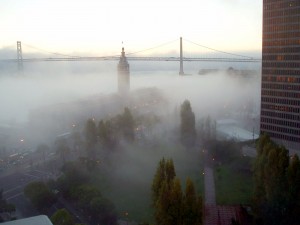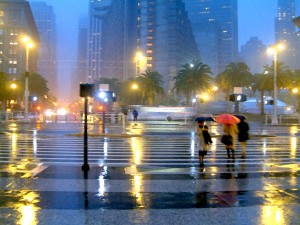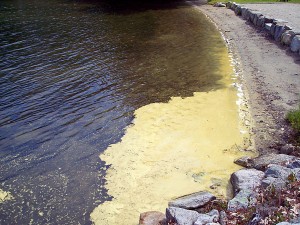 I’ve decided that after living in San Francisco for a little over 49 years that I’ve chosen to select, Embrace The Fog as my new catch phrase. I’ll start signing emails with it partly because no one signs sincerely any more because that sounds insincere or best which always makes me thing best what? or the usual, regards…regarding what? Your best insincerity? But anyway, let’s get back to the fog.
I’ve decided that after living in San Francisco for a little over 49 years that I’ve chosen to select, Embrace The Fog as my new catch phrase. I’ll start signing emails with it partly because no one signs sincerely any more because that sounds insincere or best which always makes me thing best what? or the usual, regards…regarding what? Your best insincerity? But anyway, let’s get back to the fog.
San Francisco while not being the foggiest place on earth is certainly the best known [Labrador is the foggiest]. The fog is caused by warm moist air hitting colder drier air. When the temperature outside gets close to the temperature needed to get water to condense out of the air as a liquid [dewpoint] you get fog.
San Francisco is odd in that it gets three types of fog and I’ll go into explaining the three types without hopefully putting any of you to sleep the three types are radiation, advection and tule fog. Here we go:
- Radiation fog: is formed by the cooling of land after sunset by thermal radiation in calm conditions with clear sky. The cool ground produces condensation in the nearby air by heat conduction. In perfect calm the fog layer can be less than a meter deep but turbulence can promote a thicker layer. Radiation fogs occur at night, and usually do not last long after sunrise. Radiation fog is common in autumn and early winter. This is what we see at night and in the morning that usually burns off. Tule fog is included in this, but it’s a little different.
- Advection fog: occurs when moist air passes over a cool surface by advection (wind) and is cooled. It is common as a warm front passes over an area with significant snowpack. It is most common at sea when tropical air encounters cooler waters, including areas of cold water upwelling, such as along the California coast. The advection of fog along the California coastline is propelled onto land by one of several processes. A cold front can push the marine layer coastward, an occurrence most typical in the spring or late fall. During the summer months, a low pressure trough produced by intense heating inland creates a strong pressure gradient, drawing in the dense marine layer. Also during the summer, strong high pressure aloft over the desert southwest, usually in connection with the summer monsoon, produces a south to southeasterly flow which can drive the offshore marine layer up the coastline; a phenomenon known as a “southerly surge”, typically following a coastal heat spell. However, if the monsoonal flow is sufficiently turbulent, it might instead break up the marine layer and any fog it may contain. Moderate turbulence will typically transform a fog bank, lifting it and breaking it up into shallow convective clouds called stratocumulus. This is the daytime fog that we get from time to time. It’s also when higher up the overcast cloud layer that we see so often in the Sunset and Richmond districts.
- Tule fog: is a radiation fog, which condenses when there is a high relative humidity [typically after a heavy rain], calm winds, and rapid cooling during the night. The nights are longer in the winter months, which creates rapid ground cooling, and thereby a pronounced temperature inversion at a low altitude. This is the nasty fog that it’s so thick you can sometimes not see your hand in front of your face. It’s the most dangerous type of fog to drive in as it can even obstruct car headlines and don’t even think that turn on your high beams will help as it only shines the light back into your face.
Now after reading this many of you will say, why embrace the fog then? Well, here’s the truth. Fog is actually good for you, or so many have said in the past. It was actually used as a selling point for homes in the Sunset District. It’s wet and not salty so it offers moisture to your skin. It’s also said to help people with respiratory problems. If you go to a place that’s hot and humid like say Hawaii, the heat makes you sweat and the high humidity keeps the water salty water on your skin which most people don’t like too much so they cool off with a beer which makes them sweat more causing them to actually feel worse.
Hot dry air is a different story. I made a trip many years ago to my cousin’s place in Arizona. Oddly enough I had never experienced near zero humidity weather before. To beat the heat we hit the pool and when I got out suddenly the nice wet water was sucked off my body into the dry air and I was freezing cold in 112° weather. It turns out when water evaporates quickly it sucks body heat away with it which explains how someone could be freezing in 112° weather. We’re talking like the feeling of waking up in a bathtub full of ice. It’s hard to breath as your body adjusts and people usually use some for of the phrase kill me after exiting a pool in a place like this.
We don’t have to deal with that in San Francisco. We have blankets of fog in many places unless you live in the SOMA, Bayview or Mission then you might see overcast more than fog. The term blanket of fog is actually a very good thing. Blankets keep you warm and the thick fog does hold the heat in a bit. This is why in a place like Las Vegas at night where the sand doesn’t absorb much heat the temperatures can drop pretty quickly. There’s nothing like a February morning in Las Vegas to make you scratch your head.
While we do have a couple of bad months in December and January and sometimes February where it gets wet and cold that’s not cold like people back East have to deal with. We don’t have snow [except for 1976]. We do get hail and mostly rain, but we rarely get temps that drop into the 30’s here. This is why I like the fog. It pretty much mediates any temperature extremes.
For a guy of 49 I have hardly any wrinkles starting to develop on my face and I breath pretty good. I’m beginning to believe the fog is therapeutic if for no other reason than on those few cloudless days when the West facing back of my house gets the direct attack from the sun. It is blinding and we have to close up the curtains and open up the windows because the back of our house was covered with concrete with slate shingles which love to soak up the heat and radiate it back into the house. Our heater is almost never used anymore because if we open blinds during the day our house can be 80°’s upstairs well into the evening.
Besides, if you’re a real San Franciscan the idea of falling asleep and hearing the fog horns off in the distance remind you that you’re home. So come on, join with me and embrace the fog.
@KarlTheFog, this article goes out to you.
[ad#AdBrite]
 It seems like every year I hear the same thing from places all over the Bay Area, We’re not prepared for this weather! It’s summer. It gets hot. Be Prepared. OK, maybe in San Francisco that isn’t completely true except for this year where we’ve been hit by warmer than average temperatures for this time of year, but it’s the same type of heat we get in September so we got hit a few months early. It’s not like everyone puts their air conditioning in cold storage until September. Oh wait, San Franciscans don’t have air conditioning.
It seems like every year I hear the same thing from places all over the Bay Area, We’re not prepared for this weather! It’s summer. It gets hot. Be Prepared. OK, maybe in San Francisco that isn’t completely true except for this year where we’ve been hit by warmer than average temperatures for this time of year, but it’s the same type of heat we get in September so we got hit a few months early. It’s not like everyone puts their air conditioning in cold storage until September. Oh wait, San Franciscans don’t have air conditioning.



